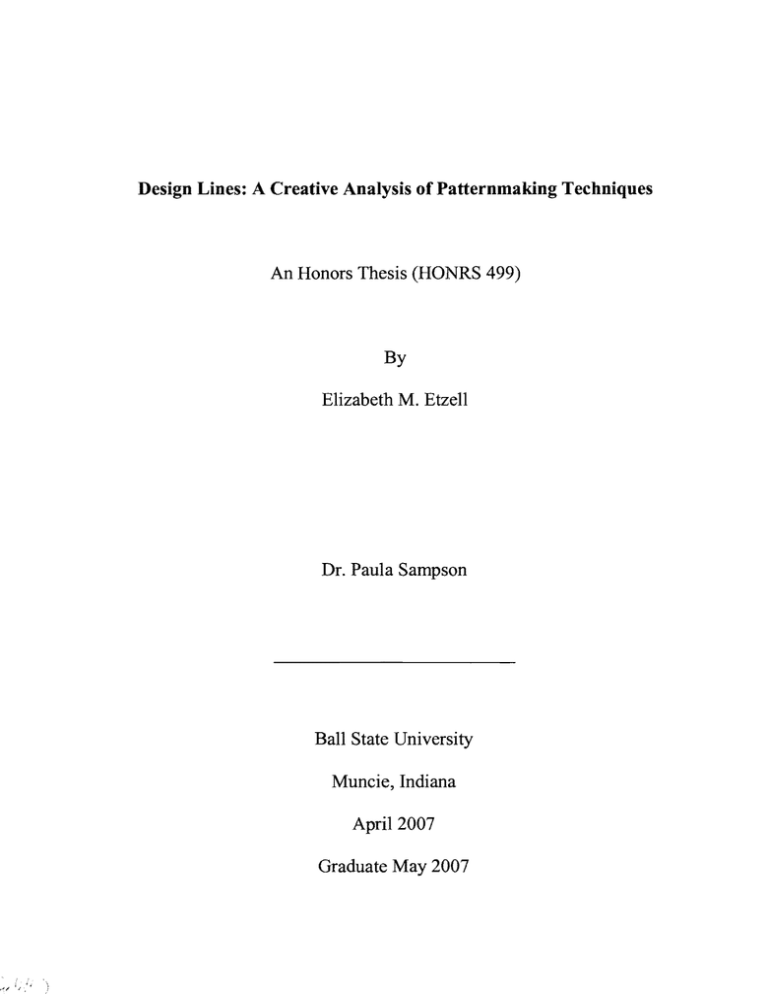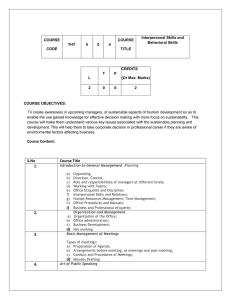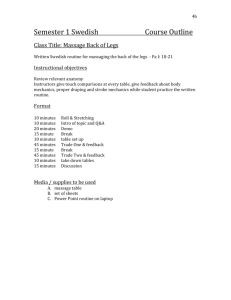Design Lines: A Creative Analysis of Patternmaking Techniques By
advertisement

Design Lines: A Creative Analysis of Patternmaking Techniques An Honors Thesis (HONRS 499) By Elizabeth M. Etzell Dr. Paula Sampson Ball State University Muncie, Indiana April 2007 Graduate May 2007 Design Lines: A Creative Analysis of Pattern making Techniques An Honors Thesis (HONRS 499) By Elizabeth M. Etzell Dr. Paula Sampson Ball State University Muncie, Indiana April 2007 Graduate May 2007 ~. t Etzell 2 Table of Contents ! .! Abstract. ............................................................................................... 3 Acknowledgements ................................................................................... 4 Written Rationale ..................................................................................... 5 Patternmaking ............................................................................... 5 Pros and Cons ................................................................................ 7 Fitting a Garment ............................................................................ 9 Conclusion .................................................................................. 10 References ............................................................................................ 12 Appendix A .......................................................................................... 13 Appendix A-I Photos of drafted pattern ................................................ 14 Appendix A-2 Photos of draped pattern ..................................... ,. '" ...... 18 Appendix A-3 Scanned images of flat pattern .......................................... 20 Appendix A-4 Photos of fitting garment.. ............................................. .22 Appendix A-5 Photos of altered seams .................................................. 24 Etzell 3 Abstract In my honors thesis I looked into the three types of pattemmaking: draping, flat pattern, and drafting. I designed a dress and made the pattern by draping muslin on a dress form, using Y.t size patterns of basic bodice and skirt patterns, and drafting out the pattern by hand using measurements from the body. Once I had a muslin mock-up, I fit the garment to a body to work on technical design aspects. My only real experience with making patterns has been a lot of draping in draping class as well as my studio class and just barely getting into flat pattern in class about two years ago. Upon completion of my project I learned much more about flat pattern and the new computer system. I also read about drafting and have a much better concept of what goes into drafting a pattern. My main goal of gaining experience with pattemmaking and technical design was accomplished and I feel like I have a much better understanding of what goes in to making a pattern and actually fitting it to a body. Etzell 4 Acknowledgements I would like to give an enormous thank you to Dr. Sampson for her inspiration into this project. I would have still been trying to decide what to do without her help. Thank you also to Audrey and Julie, the grad assistants, who helped me try and figure out the new computer system for flat pattern. Finally, thank you Ashley O'Bryan for being such a great fit model. Etzell 5 Written Rationale For my honors project I decided to look into three different ways of making patterns. I decided to use draping, flat pattern, and drafting to make three separate patterns for an outfit that I designed. I have the most knowledge and experience with draping, but have also done one sewing project as flat pattern. When I was trying to decide what kind of project I would do for my honors thesis, I really didn't know exactly what I wanted to do. I went into Dr. Sampson's office and talked to her about my career goals of becoming a pattemmaker or technical designer. Dr. Sampson suggested I do a project that would give me more experience with making patterns and fitting garments to a specific body. I thought her idea was perfect for getting a small taste of what I want to do after graduation. Pattemmaking My goals when I started this project were to make three different patterns from each of the three ways of making patterns. I also thought it would be best to make one of the patterns into a muslin prototype and fit it on a person. The very first step of this project was to come up with an outfit idea that I would make the pattern for. I chose to make a dress because I could use the concepts of this dress when I make other ones in the future and because I chose a simple flare skirt but with a yoke under the bust for a more flattering look. I first started by draping the pattern on a dress form in the sewing lab and then I made a paper pattern from the muslin pieces. The most difficult part of this project was trying to figure out how to make a pattern by flat pattern. I took the flat pattern course about two years ago and since then Etze116 Ball State has changed the entire computer system that I originally learned. My first idea was that I would be able to go into the computer and manipulate basic pattern pieces just as I had done when I did my project for the course. Once I started investigating more into the new system, I encountered a few problems. First of all there was only a select group of faculty that was trained on the new system, but they were only trained for a couple days and then the last days of training were cancelled due to snow. I went into the sewing lab and the grad assistants, Julie and Audrey, tried to help me on the computers but they said there was no way that they knew about or could find in their reference books that I could manipulate patterns in the computer and print out the pattern full size. So instead of making my flat pattern pieces on the computer, I digitized my draping pattern into the computer andjust had to manipulate Y4 scale patterns by hand. I decided to digitize the patterns I had made from draping into the computer just so I would have a tiny bit of experience with the new computer system. The method I ended up using for making a pattern with flat pattern is what I learned in my class two years ago, and is a common way of making patterns. I used Y4 size basic bodice and basic skirt patterns and manipulated them into the pieces of the dress I designed. Drafting was the only method that I have not taken a course on while at Ball State. I have been experimenting with the rough idea of drafting patterns since I was little. I would make pillows, quilts, and other crafts with patterns I drew by hand while I was still in elementary school and then once I got older I would draw out patterns for tops and even a skirt according to measurements that I had taken from my body_ Once I made Etzell 7 the gannent I would put it on myself and try to fit it more exactly. When I worked on the patterns for this project, I used a text called How to Draft Basic Patterns by Kopp, Rolfo, Zelin, and Gross to get the basic idea of how everything should be done. Once I was done with all three of the patterns, I took a look at them next to each other to see how alike or different they actually were. All of the patterns look similar and like they would make the same dress, but there were small differences with them all. The skirt patterns were all a bit different. The draped pattern had a tighter curve at the waist, a bit of an angle in the curve (not smooth like the others), and the sweep ofthe skirt was larger than both the flat pattern and drafted patterns. The front yoke of the draped pattern goes up a little bit towards the side seam while the flat pattern and drafted pattern dip down just a little bit. The bodice back is a racer back style and the draped and drafted pattern has a slightly skinnier middle part than the flat pattern. The strap on the front bodice is also a small amount skinnier than the strap on the flat pattern and drafted patterns. Pros and Cons After finally figuring out how to make the three different types of patterns, I can see a few different pros and cons concerning the different methods. The easiest method to use to make a basic pattern customized would be drafting. This is the easiest method because you can use exact measurements from the person to make the pattern so there would be little to no fit issues. I believe that draping would be the best way to make a pattern for an intricate gannent. Something with angular pleats and lots of darts or gathers would be best when draped. Flat pattern seems the best option when you are Etzell 8 doing somewhat simple outfits. It is fairly easy to manipulate the basic bodice, skirt, or pant into a new creation. All three of the methods work when you are doing standard sizes. You can use the standardized dress form, the basic pattern pieces in the standard sizes, or just use the measurements for the standard sizes. The different ways of making patterns also have their drawbacks. When you are draping an outfit to make a pattern, it takes a lot of muslin and it takes significantly more time that drafting and flat pattern. It would be ideal for custom made one of a kind outfits, but is just not practical to make a line of clothing for a retail store. When you are using flat pattern and drafting it is sometimes a little more difficult to visualize what the outfit will be like in the end. Compared to draping, flat pattern and drafting work in 2-D while creating the pattern. If I worked for a company that was making many different standard sizes and many different styles, the easiest method to use to make a pattern would be flat pattern on the computer. It would take the least amount of time, the measurements for each of the standard sizes would already be in the computer, and everything would be organized in the computer ready to send off to co-workers or the manufacturer. Companies that have smaller or fewer clothing runs would probably choose to use flat pattern as well, or even drafting since they don't have as many clothes that they produce, but they probably do need to make the standard sizes. While companies that use standard sizes need to use flat pattern and drafting, customized production is very different. When making a customized garment it would be best to take measurements of the body and draft a pattern according to the exact measurements. Some custom clothing is also made by draping, but on a dress form that Etzell 9 is an exact replica of the customer. Queen Elizabeth's clothing is made on a form that is an exact replica of her. Other factors may affect which method someone uses to make a pattern. The cheapest way to make a pattern would be drafting, because all you need is a tape measure, ruler, pencil, and paper. It is convenient for someone who is working for fun or in their home. Another option for someone who wants a cheap option would be flat pattern but by hand, not on the computer. You would need to get basic bodice, skirt, and maybe pant patterns, but other than that, you would only need a ruler, pencil, and paper. The most expensive ways would be draping and flat pattern on the computer. Draping would be expensive because the dress form is pretty costly and you would need a different one for each size. Flat pattern would be expensive on the computer, not just because of the computer itself. The software costs a lot and if you wanted to print out the pattern, you would need to have a really large expensive printer. The simplest way to make a pattern, for someone who is just starting out, would be manipulating basic pattern pieces (from paper, not on the computer). I think this would be the best way for someone with less skill because it is the cheapest, you don't have to draw the entire pattern piece from scratch, like drafting, and you don't have to work with fabric on a form to get a pattern and then transfer it onto paper. Fitting a Garment I chose to use Ashley O'Bryan as my fit model because she wore a fashion size 8 when she was in our fashion show. I also picked her because she lives with me and I knew where to find her when I needed her. So once I was done draping the pattern and Etzell 10 making in on paper, I cut out the entire dress from muslin and sewed it together into a "rough draft" version of the dress. I sewed it all together using a basting stitch and then tried it on Ashley. I only made the muslin from the pattern that I draped, not the pattern from flat pattern or drafting. Ashley was very easy to fit into the dress. It fit underneath her bust perfectly and it had a nice amount of ease at the neck line and arm holes. To make the dress fit properly, the only thing I really had to change was the side seams of the bodice and the yoke. I took in the dress at the side seam and then I just blended the side seam of the yoke into the side seam of the skirt. In total I only took in between 5/8" to 1" along the side seam. All of these adjustments I marked with a pen and then trued up once I took apart the side seams of the dress. Conclusion I really enjoyed doing this project, even though at times it got quite frustrating and stressful. I'm glad I got a small amount of experience with the new computer system for flat pattern and some more experience in general with flat pattern and drafting. I have discovered that I'm not the best at drafting, but I think that's because this was only my first project using it as a pattemmaking method. I really prefer draping, but mostly I think it is because it is the most familiar method to me. Fitting garments on a human body isn't much different than fitting on a dress form. You still need to watch out for the grain and make sure there is enough ease when the garment is on the body. In the future I really hope that I will be able to use these skills in my career. Ideally I think I would rather do pattemmaking to start, just because I have more Etzell 11 knowledge and skill in that area. Eventually I wouldn't mind leaning more about technical design and getting into that as well. Right now, my main goal is to just find a job and quick. Etze1112 References Kopp, E., Rolfo, V., Zelin, 8., & Gross, L. (1991). How to draft basic patterns. (4th ed.). New York: Fairchild Fashion & Merchandising Group, Division of Capitol Cities Media, Inc. Amaden-Crawford, C. (2005). The art offashion draping (3rd ed.). New York: Fairchild Publications, Inc. Etzell 13 Appendix A 1. Photos of drafted pattern 2. Photos of draped pattern 3. Scanned images of flat pattern 4. Photos of fitting garment 5. Photos of altered seams Appendix A-I . Etzell 1Lf Etzell 17 Appendix A-2 Etzell 18 Etzell 1g Appendix A-3 Appendix A-4 Etzell 23 ppenOIX A- ) I (! I ( \ Etzell 24 -- - -- --- Etzell 25 -




